What Is Hydroponic Growing and How Is It Done?
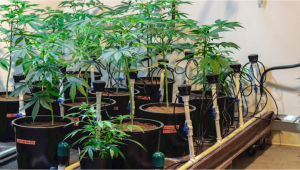
- 1. A soilless medium
- 1. a. Rockwool
- 1. b. Coco
- 1. c. Hydroton
- 2. The different types of hydroponic systems
- 2. a. Dripper systems
- 2. b. Flood and drain
- 2. c. Deep water culture
- 2. d. Nutrient film technique
- 3. Hydroponic nutrients explained
- 4. What about ph and e.c?
- 5. What's the difference between hydroponics and aeroponics?
- 6. In conclusion
After spending many years perfecting the art of organics, many will confidently make the shift to hydroponics. Seen as the most efficient way to farm on a commercial scale without the use of soil, or any growing medium that has any nutritional value, growing Cannabis with hydroponics has many benefits associated. In this article, we explain how hydroponics works, the various systems, and growing mediums, a breakdown of nutrients, and explain pH and E.C. However, hydroponic growing is far from exclusive to the world of cannabis seeds. Vegetable growers have harnessed this technology for years to grow food in vertical stacks without using a single particle of soil. Hydroponics boasts an array of benefits that make the growing methodology so attractive to commercial cultivators and hobbyist growers alike. These include faster growth rates, bigger yields, and cheaper running costs.
At first glance, it might seem like growing this way uses a lot of water and therefore isn’t as environmentally friendly as it first seems. However, hydroponics uses a lot less water than growing in soil. You see, every time you water the soil, plenty of the administered water simply flows through the pores spaces of different fractions of the soil and disappears. In contrast, the water in a well-designed hydro system simply nourishes plant routes and, depending on the system, recirculates back into the reservoir, picks up more nutrients and oxygen, and heads right back out to the root zone and back into the cycle once more.
1. A Soilless Medium
Traditional organic farming relies on the natural decomposition of organic matter, with the aid of benevolent bacteria and fungi. Like the roots of a Cannabis plant bond to the beneficial microorganisms and form a symbiotic relationship, the soil food web will provide all the primary nutrients and trace elements to the plants when they demand them.
Feeding plain water or a liquid-based nutrient heavy in carbon is all a grower needs to keep the plants happy. The organic growing medium acts as a slow moving buffering system, allowing a grower to have much more flexibility if over or under-watered. When it comes to hydroponics, the growing medium that is used will be an inert medium. This basically means unlike organic substrates, it contains no nutritional value whatsoever. Thanks to the diversity of hydroponic systems. A grower can choose which growing medium they prefer to use, and which is more practical for them.
However, these materials aren’t truly a growing medium. Instead, they simply hold the seedling while the plants are young and act as structural support. The roots actually grow down into the water—the true growing medium. But we’re not talking about plain old tap water here. The water used in hydroponic systems is regulated to sit at an optimal pH. It also contains an array of macronutrients and micronutrients that cannabis plants need to thrive. Finally, the water also contains enough dissolved oxygen to keep the roots of cannabis plants thriving.
Rockwool
Rockwool - A yellow colored wool fiber that is produced by spinning rock materials. It is also the same stuff used for insulation and soundproofing, so you may be more familiar with rockwool than you think.
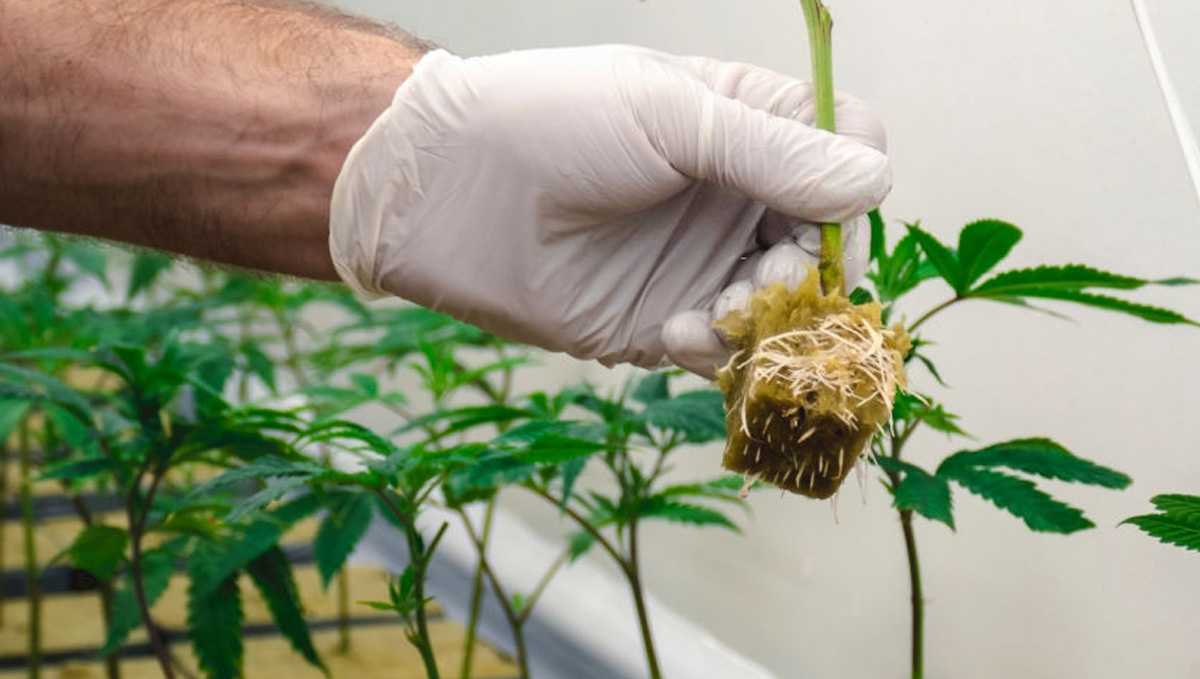
The Benefits
- Rockwool can hold up to 18 times its own weight in water
- Dripper systems can feed between 3-5 times per day
- Used in commercial farming to produce massive yields
- Available in cube size for clones, meter-long slabs, and large cubes.
- Ideal for holding onto water in the event of a pump failure or power cut.
Coco
Coco - A very light and airy substrate produced from the hairs of coconut husks. Once treated and washed for any salts that may have accumulated during collecting, coco fibre is an excellent growing medium for encouraging a prolific root zone.
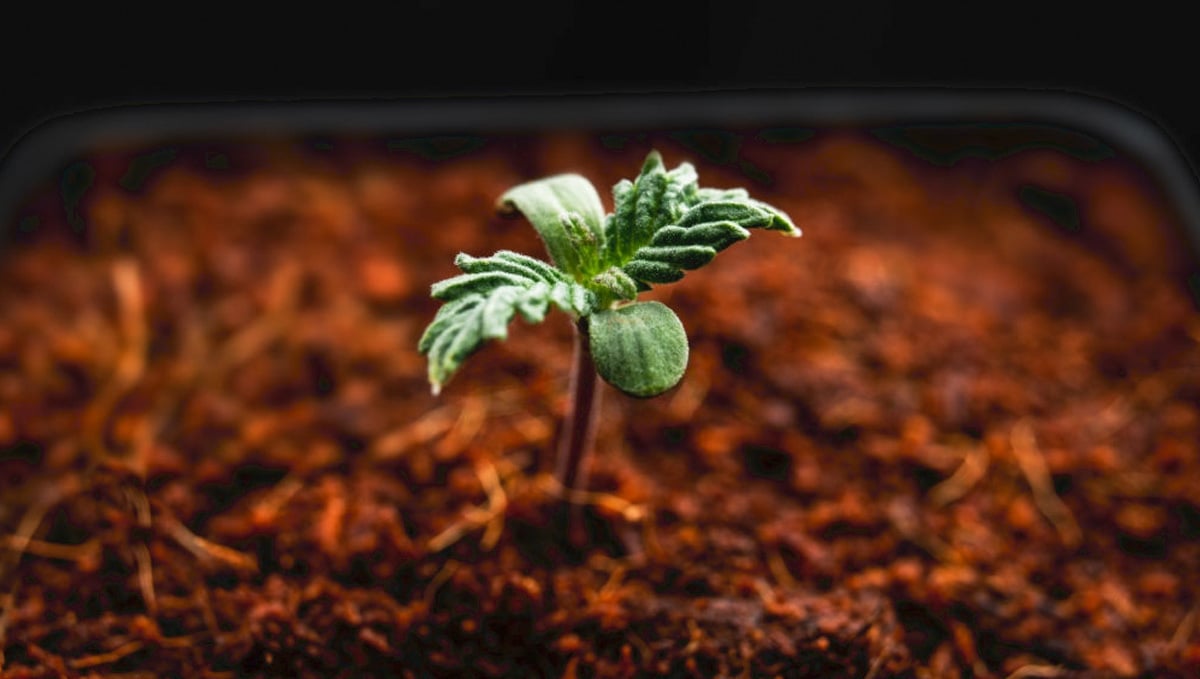
There are nutrients that are specially created for coco, as the way that coco retains nutrients is different from rockwool and hydroton. Often combined at a 50/50 ratio with perlite in order to create the ultimate dry to wet period between feeds.
The Benefits
- Coco contains lots of air pockets which is what encourages a large root mass.
- Water retention is very high with coco and does not overwater easily.
- Mainly used for top dripper systems that use the runoff or recirculation method.
- Coco mixes with other substrates such as perlite, hydroton, and vermiculite very well.
Hydroton
Hydroton - These are small orange clay balls traditionally used in landscaping. Hydroton is often used to mix with coco to add more air pockets or is used solely in deep water culture, and recirculation top dripper systems.
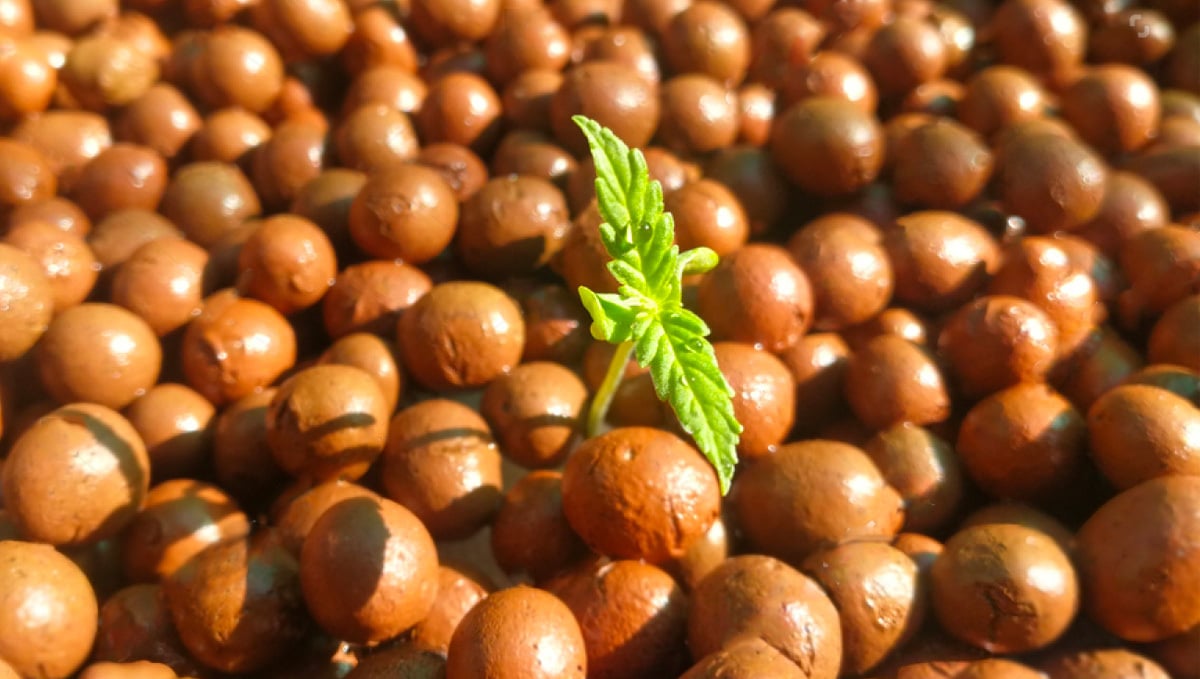
The Benefits
- It is impossible to overwater your plants when using hydroton.
- Recirculating systems using hydroton can be left on 24/7 if desired.
- Mixing with coco at a 50/50 ratio will provide a very light and airy medium.
- As long as they are washed after a grow cycle, they can be reused every time.
2. The Different Types of Hydroponic Systems
Dripper Systems
Recently there has been a rise on social media of the home grower using drip stakes, with either coco, rockwool, or pure hydroton. Dripper systems are the entry-level for hydroponic growers and don’t cost much in terms of finance, time, and maintenance.
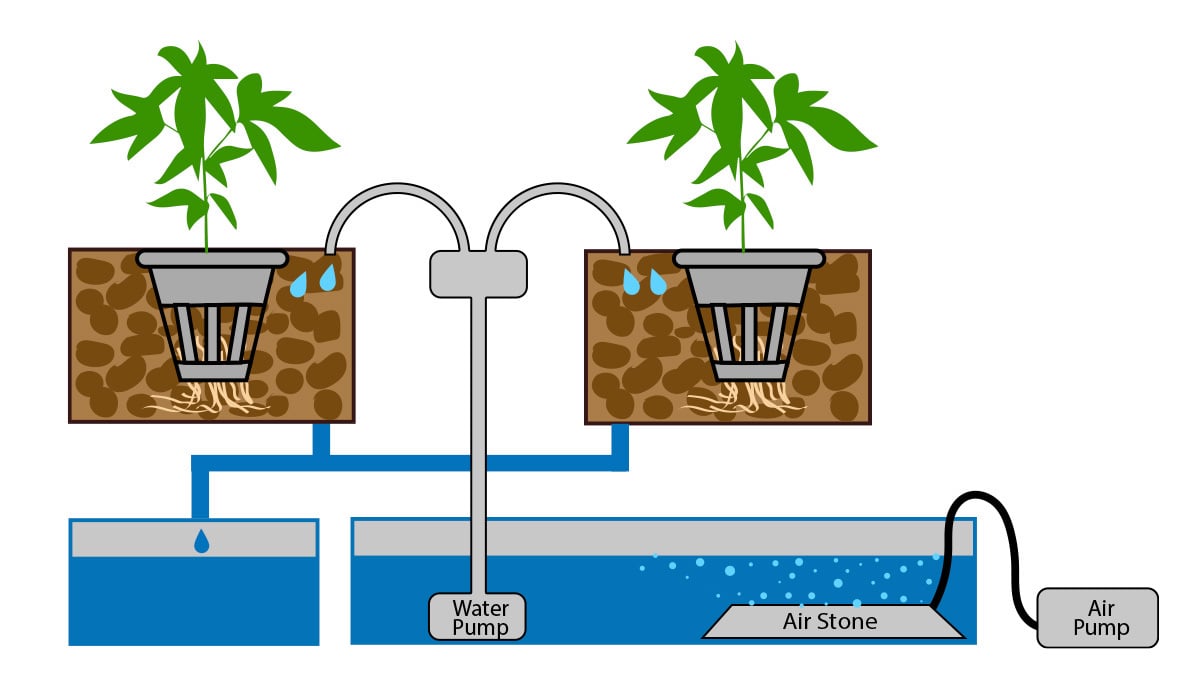
During the vegetative stage it is advised to feed the plants 1-3 times per day depending on the length of the growth period, and 3-5 times during flowering. Dripper systems are fantastic for keeping a consistent nutrient solution and providing the plants with a consistent feeding time programmed to a 15-minute segment timer.
Flood and Drain
Not as commercially popular as other hydroponic systems, flood, and drain produces huge yields from small plants grown close together. Feeding times can fluctuate between 5-10 feeds a day in some cases.
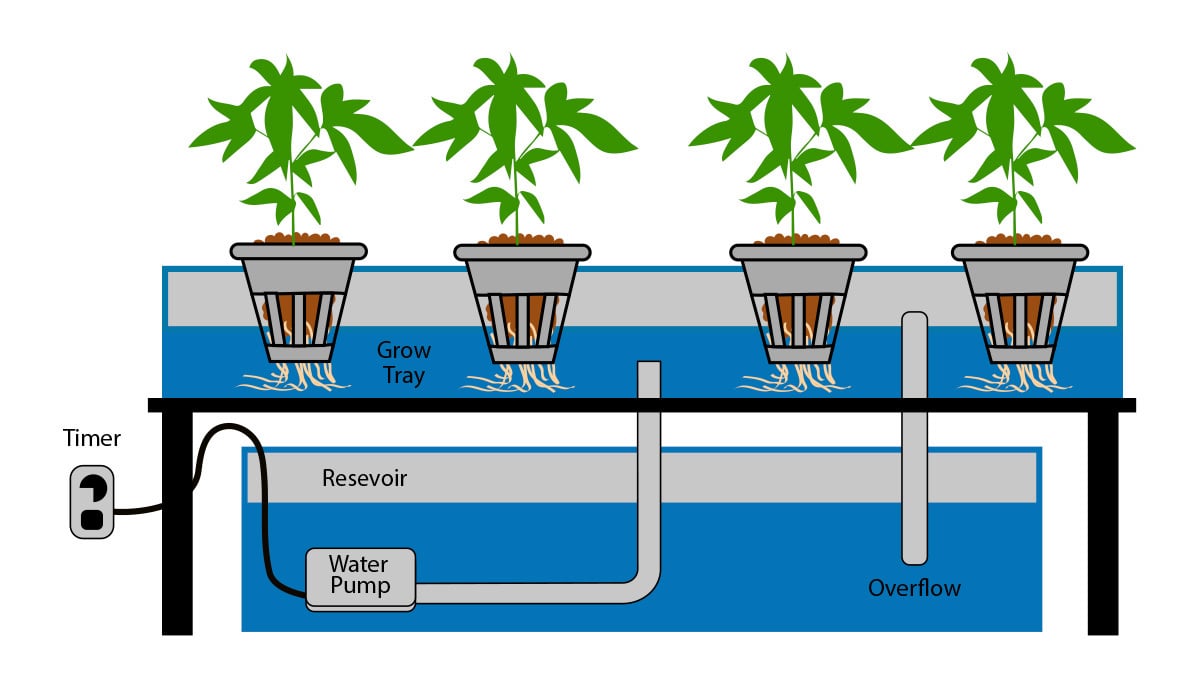
A growing medium of pure hydroton must be used and clones or seedlings, planted in a 4-6 inch layer of hydroton. The benefit of using a flood and drain table is oxygen is flushed around the roots and then flooded with a nutrient solution.
Deep Water Culture
Using an air stone, air pump, plastic bucket, and net pot, deep water culture allows the roots of a plant to sit suspended in the nutrient solution 24/7. D.W.C are well known for producing epic yields and will produce some massive nutrient, hungry ladies.
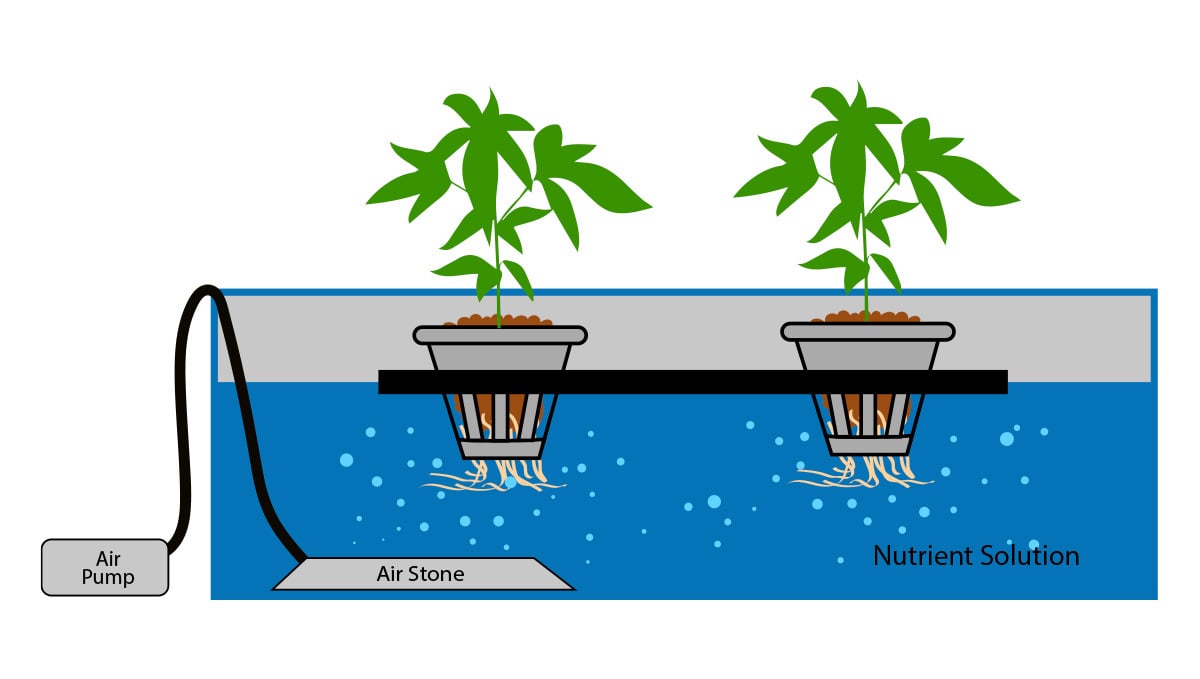
Out of all of the systems, deep water culture requires the most maintenance and can also have the highest risk to reward factor. If you are growing with D.W.C it is crucial that the roots do not become infected with pathogens present in the water, potentially killing your crop, especially if you are using a recirculating deep water culture system.
Nutrient Film Technique
These systems are used for growing lettuce commercially and require small-sized plants. When growing Cannabis in an N.F.T system using rockwool cubes, the results can be incredible causing the roots to grow so large they consume the entire reservoir including the pump.
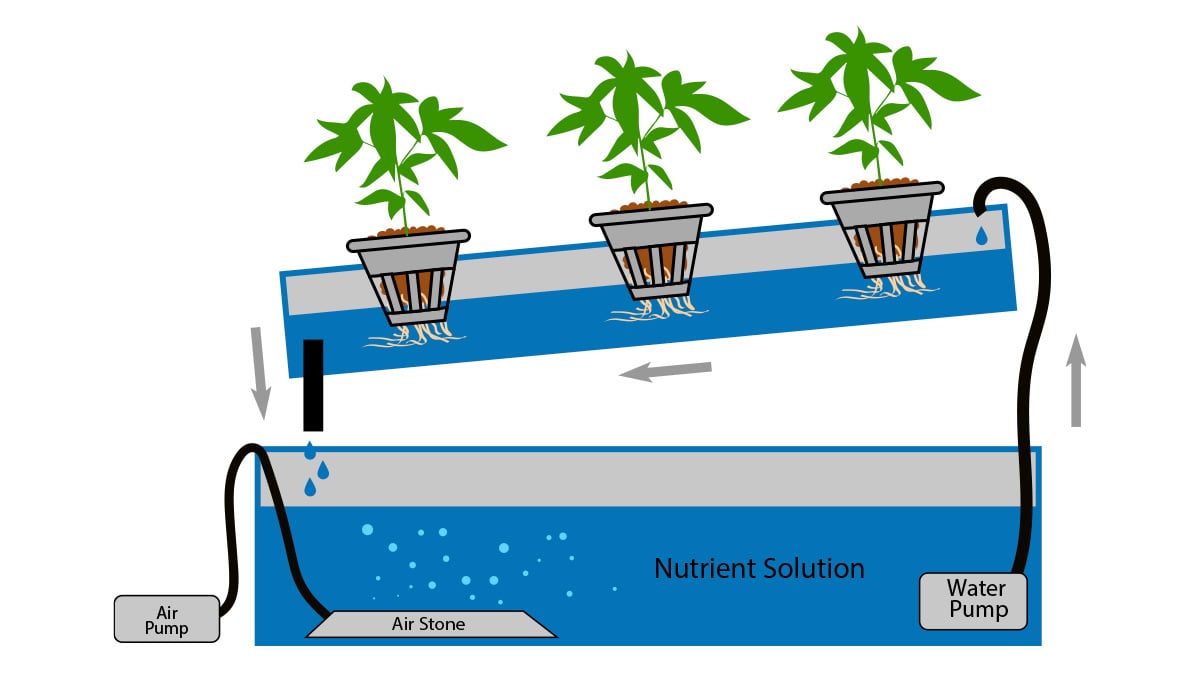
These systems are very easy to use, require a small amount of maintenance, and are an excellent choice for beginner growers wanting to try their hand at hydroponics. Another advantage of using an N.F.t system indoors is how low the plants sit off the floor allowing growers with limited space to have no issues.
3. Hydroponic Nutrients Explained
Using an inert hydroponic medium depends heavily on nutrients being readily available to the plant's roots. There is no 72-hour buffering period as associated with hydroponics so extra care and attention must be taken. The best way to describe the difference between organic and hydroponic compounds is the size. Hydroponic nutrients are created from chemical salts in far smaller chelate-sized minerals, which can be absorbed by the plant instantly. When investing in nutrients, you will find that hydroponic brands will provide the feed in 2 or 3 parts.
For example, Grow Nutrient Part A+B will contain all of the necessary nutrients, however, cannot be combined and must be kept in separate labeled bottles. When using chemical nutrients, it is very important to mix your nutrients correctly according to the feeding chart.
4. What About pH and E.C?
Two essential parts of correctly feeding your Cannabis plants, that dictate nutrient availability and uptake. Electric conductivity will determine the strength of the nutrient solution and be measured in parts per million (PPM).
What To Consider
- Adding nutrient solution can cause the pH to fluctuate so add pH up or down at the last stage of your nutrient solution mix. Adjusting your pH levels before adding the numerous nutrients can be a long-winded game that will only cause frustration.
- Using a pen designed to test pH and E.C will give an accurate reading as you prepare your nutrients. Testing the electric conductivity of the drain to waste runoff in a dripper system will give you a good indication of how much the plants are using.
- Different cultivars are more nutrient hungry than others, so do not base every strain on the same E.C. It is better to start low and work your way up, then make a fatal jump and find out the hard way.
5. What's the difference between Hydroponics and Aeroponics?
Despite working in a fairly similar way, hydroponics vs aeroponics have minor differences, mainly in how they deliver the nutrients to the roots. In hydroponic setups, the roots are suspended in water at all times or are fed by an intermittent or continuous flow of nutrient solution. On the other hand, in aeroponic setups, the roots are never placed into the water because this type of setup delivers the nutrient solution to the roots with mist nozzles that mist the nutrients directly to the roots. So basically, the main difference is what gives each method its name, As 'aero' in Aeroponics means air while 'hydro' in Hydroponics means water.
The Pros and Cons of Aeroponics
And just like any other thing in life, aeroponics has its pros and cons. So let’s read a bit more about them.
PROS
- No growing medium results in maximum nutrient absorption
- Explosive plant growth due to roots being exposed to oxygen at all times
- Bigger plants and bigger yields
- More efficiency results in less water and nutrient usage
- Maximizes grow area as you can grow several plants in a relatively small aeroponic setup
- Easy to add new plants to the system as there’s no need to deal with substrates
CONS
- Requires constant attention to pH and EC as roots are directly exposed to the nutrient solution
- The initial setup cost is higher than regular growing methods
- Needs to be cleaned and maintained regularly
- Needs constant supervision in case any of the parts of the system breaks
- You’re at the mercy of power outages as the equipment depends on electricity
- A certain degree of knowledge is needed to set up the system and keep it functioning correctly
6. In Conclusion
Hydroponic growing takes a great deal of commitment, buying nutrients on a regular basis, running the risk of blind spots and pathogens, and most importantly the skill and experience. We advise spending time reading and watching tutorials about growing Cannabis in hydroponic systems and learning which system is ideal for your grow space, skill level, budget, and maintenance.








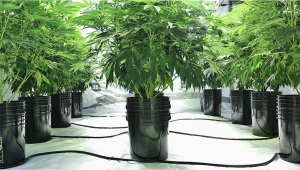
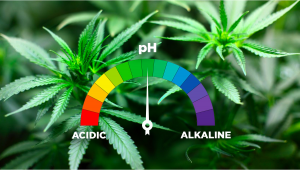
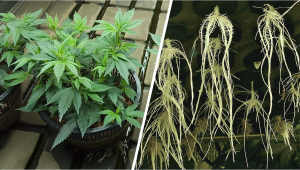

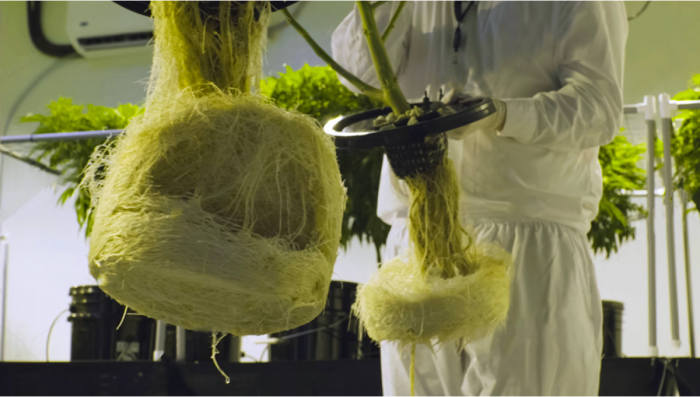
Comments